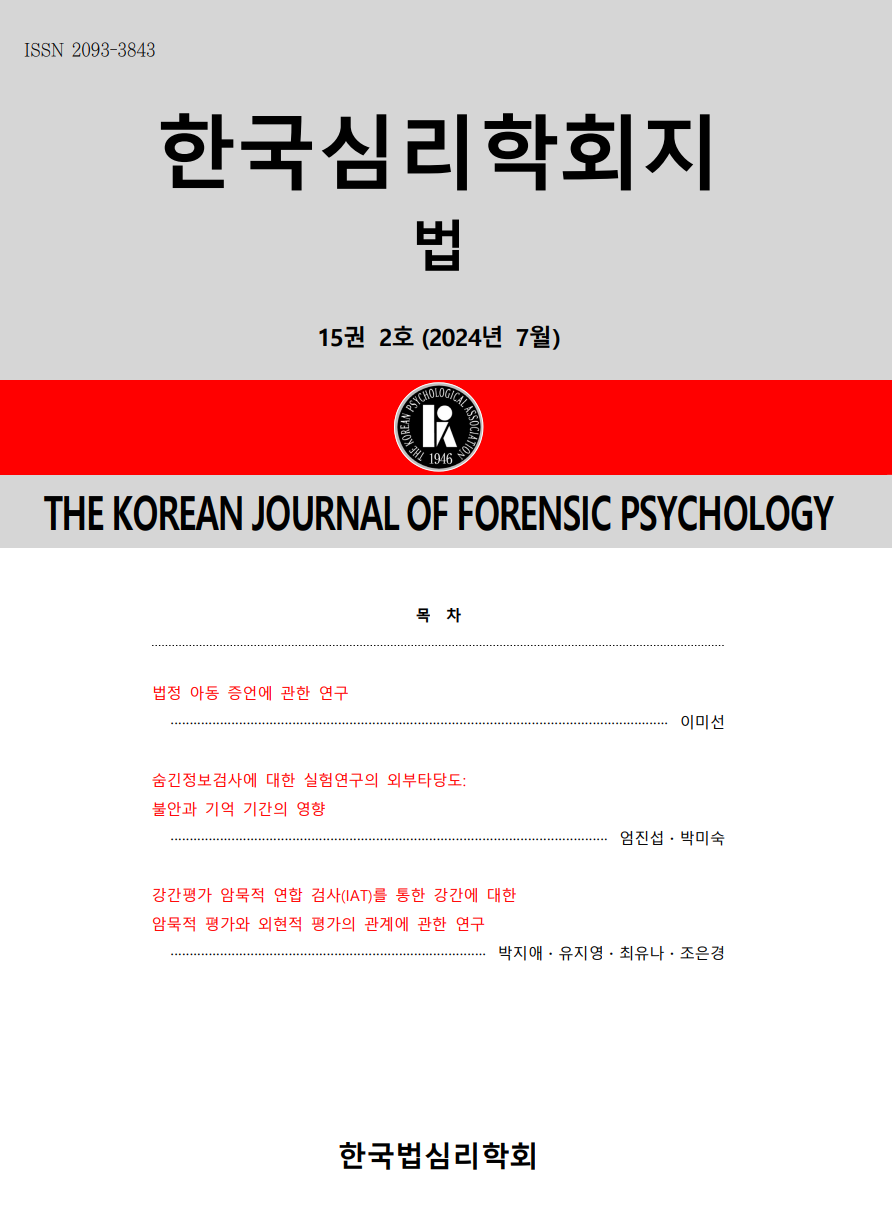open access
메뉴
open access
메뉴 ISSN : 2093-3843
ISSN : 2093-3843
The aim of the present study was to investigate the effect of the lineup modes and own-race bias on the performance of Korean eyewitnesses. We hypothesized that participants would show own-race bias and that they would show higher discriminability in simultaneous lineups than sequential lineups. We also examined the interaction effects between the two independent variables. Participants completed 8 lineup trials, which were manipulated by a 2 (target race: Asian, white) × 2 (target presence, target absence line-up) × 2 (lineup mode: sequential lineup, simultaneous lineup) within-subject design. The results were then analyzed through logistic regression analyses and G statistics test for d'. As a result, the own-race bias was significant, but the simultaneous lineup superiority effect was not found. In addition, participants showed significant own-race bias in simultaneous lineups, but not in sequential lineups. The current study demonstrated that own-race bias was replicated for Korean participants. Finally, we discussed the reason why the current study failed to demonstrate the superiority effect of simultaneous lineups, and explained the implications of the interaction effect between lineup modes and the own-race bias.
When it comes to sentencing sex crimes in our society, there is a growing criticism that the level of punishment is excessively lenient and that the trials are centered around the perpetrators. Therefore, there is a need to examine what factors cause this generous sentencing. The purpose of this study is to investigate the factors affecting the sentencing of rape among sex offenses by analyzing judgement. In particular, the analysis was conducted focusing on probation and sentencing, which are the most problematic parts of the sentencing for rape. For this purpose, 637 cases of rape cases in which a upper instance exists, included in the judgment database, were analyzed. As a result of the analysis, it was found that the factor that has the greatest influence on the sentence of probation and sentence of the defendant was the recognition of the absence of punishment, a special sentencing factor. If ‘the victim opposes punishment’ is recognized, the likelihood of the probation increases and the sentence is significantly reduced. In addition, it was found that the absence of punishment had a significant effect on the change of the sentence of the lower court from a higher court to a suspended sentence. These findings indicate a controversy surrounding the current sentencing standards and emphasize the necessity of thoroughly considering improvements to the sentencing system in the future. Finally, the study discussed the limitations, provided suggestions for future research, and explored the implications of the findings.
In this study, the PPI-R was used to categorize the subtypes of psychopathic tendencies of criminals. The PAI results for each type were then used to determine the personality traits associated with. A total of 555 offenders(415 males, 140 females)were investigated. Using the LPA of their PPI-R results to select the subgroup, the BCH was employed to determine whether personality traits from the PAI results varied by group. The moderating effect analysis was then used LPA to identify the personality factors that regulate the impact of psychopathic tendencies on antisociality, and the Johnson-Neyman approach was employed to determine the cutting point. Lastly, to create the SORT-TEST, ROC, random forest, and confirmatory factor analysis were carried out. As a result, first, four subgroups were extracted. Group 1: Self-overvaluation, Group 2: General offender, Group 3: Controlling domination, and Group 4: Impulsive self-centered. Second, when comparing the PAI personality traits for each group, group 4 scored highest on the clinical scale. A high DOM was present in Groups 1 and 3. The RXR was lowest in Group 4. Third, the study of the moderating effect on antisociality by group revealed that Group 1 exhibited significant moderating effects in SOM, ANX, and ARD, Group 2 demonstrated ANX and BOR, Group 3 demonstrated DOM, and Group 4 demonstrated the majority of the variables. Fourth, The SORT-TEST of 30 questions was developed. According to the findings, several therapeutic strategies are required depending on the traits of psychopathic tendencies. Finally, the study’s limitations and implementation strategies were presented.